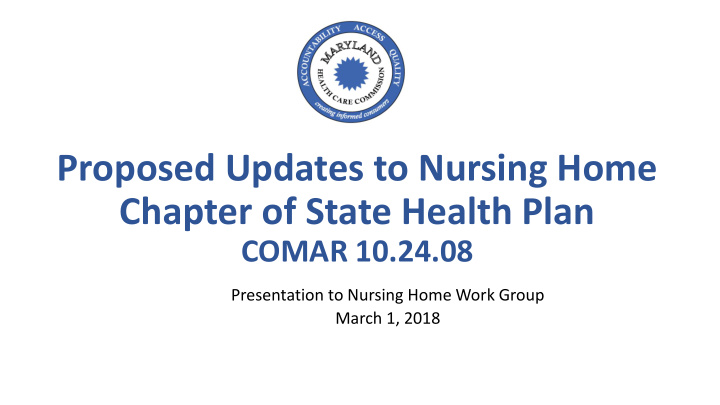



Proposed Updates to Nursing Home Chapter of State Health Plan COMAR 10.24.08 Presentation to Nursing Home Work Group March 1, 2018
Proposed Chapter Revisions 2
Simplifying the CON Process Issues Current NH Chapter Proposed NH Chapter Goal Modify Waiver bed rules Establish some restrictions on Any beds not licensed within one Reduce “paper beds” in inventory. waiver beds; eliminate bed year to expire one year after “banking”. approval. Add Docketing Rules and No docketing rules Docketing rules qualifying Clarify rules up front to reduce Exceptions applicants star ratings of 3 stars or delayed and unnecessary reviews. higher; meeting previous CON conditions; no fraud or abuse. No docketing exceptions - Consider docketing exception to Foster relationships consistent applications that increase the nursing home bed need for with the total cost of care model. state inventory of publically projects demonstrating risk available nursing home beds must sharing agreements between be in conformance with published hospitals and nursing homes to bed need projections reduce total cost of care. Consider docketing exception to Need for higher quality choices nursing home bed need for for consumers. jurisdictions with high proportion of CCFs with below average rating on NH Compare. 3
Integrating Nursing Homes into Continuum of Care Issues Current NH Chapter Proposed NH Chapter Goal Nursing home-hospital General standards on collaborative Nursing homes should Encourage cooperation between coordination relationships demonstrate effective hospitals and post-acute collaboration with hospitals. providers to reduce length of stay and costs. Nursing home-community General standards on collaborative Nursing homes should Linkages to reduce length of stay coordination relationships demonstrate effective in nursing homes and provide collaboration with home health care in the most appropriate and agencies and hospices. least restrictive setting. 4
Increasing Focus on Quality Issues Current NH Chapter Proposed NH Chapter Goal Consumer choice “The Commission, through its Incorporate selected quality Encourage consumer choice as Nursing Home Performance metrics from the most recent well as focus on quality. Evaluation Guide, will report Nursing Home Compare quality current data … in order to assist measures into standards used for consumers in decision-making CON review. regarding long term care services.” Docketing rule No docketing rules Propose not docketing an Implement quality measures application from a nursing home before applications are accepted (or chain) with overall star rating of for review. one or two stars (or high proportion of NHs with below average rating) 5
Implementing Innovative Design Issues Current NH Chapter Proposed NH Chapter Goal FGI Guidelines Facility and unit design to meet Nursing home design to meet FGI Provide more specific and residents’ needs. Guidelines. measurable standards. Person-centered care Reduce rooms with more than 2 Cluster/neighborhood design Incorporate elements of person- beds per room; individual temp rather than institutional design, as centered care. controls; no more than 2 residents defined by FGI Guidelines. share toilet. Specialty units Identify types of residents Identify types of residents served Provide more specific and intended to serve and cite and meet specific licensing measurable standards. literature re best design. (COMAR) regulations as well as FGI Guidelines. 6
Nursing Home-Hospital Collaboration 7
Questions for Discussion: • What are the major issues nursing homes face in admitting certain patients from hospitals? Do specific categories of patients pose particular challenges? • What are the risks and benefits for nursing homes in working with hospitals under risk sharing arrangements? What risks should hospitals/nursing homes be willing to assume? • How are nursing homes working with HSCRC to develop post-acute networks? • Are there standards for how such contracts between hospitals and nursing homes should be structured? • Are there specific clinical conditions that lend themselves to such arrangements? • What specific examples exist in Maryland for risk sharing arrangements? 8
Nursing Home Bed Need Methodology 9
Key Features of the Current Nursing Home Bed Need Methodology • Bed need is projected on a jurisdictional basis; • Use rates are age-adjusted; • Baseline use rates are reduced by 5%; • Migration within Maryland is adjusted using assumptions about retention rates and use rates to take in- and out-migration into account; • A community-based services adjustment is included, based on an assumption that some nursing home services could be provided outside of the nursing home setting; • The projection horizon is seven years from the base year; and • Household population data is used. 10
Critique of the Current Bed Need Methodology • Some of the data requirements are based on MDS 2.0 data, which is now obsolete; • Parts of the methodology are complex and difficult to replicate; • Some assumptions are not fully explained; • The migration matrix is very complex to use; • The projection horizon (seven years) may be too long; and • Total population data, rather than household population, should be used, consistent with other MHCC methodologies. 11
Proposed New Bed Need Methodology • Take into account patterns of use by age by modeling demand using observed rates of change in use rates; • Simplify the migration adjustment by means of net in- and out- migration; • Factor in use of Maryland nursing homes by non-Maryland residents; • Shorten the projection horizon to five years from the base year; • Use total estimated and projected population; and • Add a jurisdictional occupancy standard as a final step in making a finding of net bed need. 12
Questions for Discussion: • What is your assessment of the current nursing home bed need methodology in terms of reasonably predicting the use of nursing home beds in Maryland? • Does the projected approach take into account current patterns of utilization? • Where do you see areas of unmet need in the state? 13
Next Steps • Summarize Work Group meeting, issues, and recommendations. • Draft update to Nursing Home Chapter of State Health Plan. • Present draft to Commission for approval. • Hold Informal Public Comment period. • Review and summarize comments and make necessary changes. • Present to Commission for approval as proposed permanent regulations. • Complete the promulgation process. 14
Recommend
More recommend